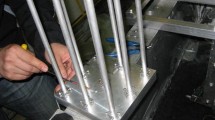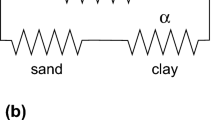Abstract
This work aimed to propose a semi-empirical model that predicts the permeability of saturated clay using the data of mercury intrusion porosimetry (MIP). First, the pore size distribution (PSD) curve obtained from an MIP test was regarded as a discrete probability function of pore diameters; thus, its shape could be characterized by probability parameters (e.g., the expected value and the standard deviation). Subsequently, these probability parameters, combined with the microporosity calculated from the volume of intruded mercury, were correlated with the permeability of clay based on Hagen-Poiseuille's equation. Next, the performance of the proposed permeability model was verified using data reported in the literature. Thereafter, the model was applied to estimate the permeability of normally consolidated (NC) and overconsolidated (OC) kaolin subjected to various triaxial loading. The results highlighted that the proposed model is capable of characterizing the sensitive variation of kaolin permeability under different overconsolidation ratios (OCRs), stress paths, and stress levels.
Similar content being viewed by others
References
Al-Tabbaa, A. and Wood, D. M. (1987). “Some measurements of the permeability of kaolin.” Geotechnique, Vol. 37, No. 4, pp. 499–514, DOI: 10.1680/geot.l987.37.4.499.
Bello, A. A. (2013). “Hydraulic conductivity of three compacted reddish brown tropical soils.” KSCE Journal of Civil Engineering, Vol. 17, No. 5, pp. 939–948, DOI: 10.1007/sl2205-013-0155-x.
Carman, P. C. (1956). Flow of gases through porous media, Butterworths, London, UK.
Chapuis, R. P. (2012). “Predicting the saturated hydraulic conductivity of soils: A. review.” Bulletin of Engineering Geology and the Environment, Vol. 71, No. 3, pp. 401–434, DOI: 10.1007/sl0064-012-0418-7.
Delage, P., Cui, Y. J., and Tang, A. M. (2010). “Clays in radioactive waste disposal.” Journal of Rock Mechanics and Geotechnical Engineering, Vol. 2, No. 2, pp. 111–123, DOI: 10.3724/SP.J.1235. 2010.00111.
Delage, P. and Lefebvre, G. (1984). “Study of the structure of a sensitive Champlain clay and of its evolution during consolidation.” Canadian Geotechnical Journal, Vol. 21, No. 1, pp. 21–35, DOI: 10.1139A84-003.
Dong, H., Huang, R., and Gao, Q. F. (2017). “Rainfall infiltration performance and its relation to mesoscopic structural properties of a gravelly soil slope.” Engineering Geology, Vol. 230, pp. 1–10, DOI: 10.1016/j.enggeo.2017.09.005.
Gao, Q. R., Dong, H., Huang, R., and Li, Z. R. (2019). “Structural characteristics and hydraulic conductivity of an eluvial-colluvial gravelly soil.” Bulletin of Engineering Geology and the Environment, Vol. 78, No. 7, pp. 5011–5028, DOI: 10.1007/sl0064-018-01455-l.
Gao, Z. and Hu, Q. (2013). “Estimating permeability using median pore-throat radius obtained from mercury intrusion porosimetry.” Journal of Geophysics and Engineering, Vol. 10, No. 2, DOI: 10.1088/1742-2132/10/2/025014.
Gao, Q. R., Jrad, M., Ighil Ameur, L., Hattab, M., and Fleureau, J. M. (2018). “Dilatancy phenomenon study in remolded clays - A. micro-macro investigation.” Proceedings of China-Europe Conference on Geotechnical Engineering, Springer, Cham, Switzerland, pp. 148–152.
Garcia-Bengochea, I. (1978). The relation between permeability and pore size distribution of compacted clayey silts, MScE Thesis and Joint Highway Research Project Report, Purdue University, West Lafayette, IN, USA.
Garcia-Bengochea, I., Altschaeffl, A. G., and Lovell, C. W. (1979). “Pore distribution and permeability of silty clays.” Journal of the Geotechnical Engineering Division, Vol. 105, No. 7, pp. 839–856.
Juang, C. H. and Holtz, RD. (1986). “A probabilistic permeability model and the pore size density function.” International Journal for Numerical and Analytical Methods in Geomechanics, Vol. 10, No. 5, pp. 543–553, DOI: 10.1002/nag.l610100506.
Kong, L. R. (2007). Microstructural behavior of saturated soft clay and an elasto-plastic constitutive model considering microstructure, PhD Dissertation, Tongji University, Shanghai, China (in Chinese).
Lapierre, C., Leroueil, S., and Locat, J. (1990). “Mercury intrusion and permeability of Louiseville clay.” Canadian Geotechnical Journal, Vol. 27, No. 6, pp. 761–773, DOI: 10.1139/t90-090.
Lei, H., Wu, Y., Yu, Y., Zhang, B., and Lv, H. (2016). “Influence of shear on permeability of clayey soil.” International Journal of Geomechanics, Vol. 16, No. 5, DOI: 10.1061/(ASCE)GM.1943-5622.0000636.
Leonards, G. A. (1962). Foundation Engineering, McGraw-Hill, New York, NY, USA.
Li, Z., Katsumi, T., Inui, T., and Takai, A. (2013). “Fabric effect on hydraulic conductivity of kaolin under different chemical and biochemical conditions.” Soils and Foundations, Vol. 53, No. 5, pp. 680–691, DOI: 10.1016/j.sandf.2013.08.006.
Mesri, G. and Olson, R. E. (1971). “Mechanisms controlling the permeability of clays.” Clays and Clay Minerals, Vol. 19, No. 3, pp. 151–158, DOI: 10.1346/CCMN.1971.0190303.
Nagaraj, T. S., Pandian, N. S., and Narasimha-Raju, P. S. R. (1993). “Stress state permeability relationships for fine-grained soils.” Geotechnique, Vol. 43, No. 2, pp. 333–336, DOI: 10.1680/geot.l993.43.2.333.
Ninjgarav, E., Chung, S. G., Jang, W. Y., and Ryu, C. K. (2007). “Pore size distribution of Pusan clay measured by mercury intrusion porosimetry.” KSCE Journal of Civil Engineering, Vol. 11, No. 3, pp. 133–139, DOI: 10.1007/BF02823892.
Penumadu, D. and Dean, J. (2000). “Compressibility effect in evaluating the pore-size distribution of kaolin clay using mercury intrusion porosimetry.” Canadian Geotechnical Journal, Vol. 37, No. 2, pp. 393–405, DOI: 10.1139/t99-121.
Ranaivomanana, H., Razakamanantsoa, A., and Amiri, O. (2016). “Permeability prediction of soils including degree of compaction and microstructure.” International Journal of Geomechanics, Vol. 17, No. 4, DOI: 10.1061/(ASCE)GM.1943-5622.0000792.
Samarasinghe, A. M., Huang, Y. H., and Drnevich, V. P. (1982). “Permeability and consolidation of normally consolidated soils.” Journal of the Geotechnical Engineering Division, Vol. 108, No. 6, pp. 835–850.
Schaap, M. G. and Lebron, I. (2001). “Using microscope observations of thin sections to estimate soil permeability with the Kozeny-Carman equation.” Journal of Hydrology, Vol. 251, No. 3, pp. 186–201, DOI: 10.1016/S0022-1694(01)00468-1.
Tavenas, E., Leblond, P., Jean, P., and Leroueil, S. (1983). “The permeability of natural soft clays. Part I: Methods of laboratory measurement.” Canadian Geotechnical Journal, Vol. 20, No. 4, pp. 629–644, DOI: 10.1139/t83-072.
Taylor, D. W. (1948). Fundamentals of soil mechanics, John Wiley & Sons, New York, USA.
Yuan, S. Y., Liu, X. E., and Buzzi, O. (2018). “Effects of soil structure on the permeability of saturated Maryland clay.” Geotechnique, Vol. 69, No. l,pp. 72–78, DOI: 10.1680/jgeot.l7.p.l20.
Zeng, L., Liu, J., Gao, Q. E., and Bian, H. (2019). “Evolution characteristics of the cracks in the completely disintegrated carbonaceous mudstone subjected to cyclic wetting and drying.” Advances in Civil Engineering, Vol.2019, Article ID 1279695, pp. 1–10, DOI: 10.1155/2019/1279695.
Zhou, H. (2013). Study on soft soil microstructure and mechanism of seepage and consolidation in Pearl River Delta (PRD), PhD Dissertation, South China University of Technology, Guangzhou, China (in Chinese).
Zuo, C., Liu, D., Ding, S., and Chen, J. (2016). “Micro-characteristics of strength reduction of tuff residual soil with different moisture.” KSCE Journal of Civil Engineering, Vol. 20, No. 2, pp. 639–646, DOI: 10.1007/sl2205-015-0408-y.
Acknowledgments
This work was supported by the National Natural Science Foundation of China (Nos. 51838001, 51878070, 51878078) and the Hunan Key Laboratory of Geomechanics and Engineering Safety, China (No. 16GES04). The authors appreciate the help of Dr. Lamine Ighil-Ameur with regard to triaxial testing.
Author information
Authors and Affiliations
Corresponding author
Rights and permissions
About this article
Cite this article
Gao, QF., Zhao, D., Zeng, L. et al. A Pore Size Distribution-based Microscopic Model for Evaluating the Permeability of Clay. KSCE J Civ Eng 23, 5002–5011 (2019). https://doi.org/10.1007/s12205-019-2219-z
Received:
Accepted:
Published:
Issue Date:
DOI: https://doi.org/10.1007/s12205-019-2219-z




